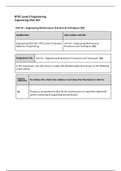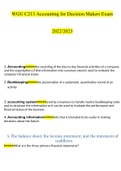Essay
BTEC Level 3 Engineering: Unit 44 (D1) – Engineering Maintenance Procedures and Techniques
- Vak
- Instelling
- Boek
You will receive a 5 page fully detailed assignment answer to the following question: D1: Produce a comprehensive plan for the maintenance of a specified engineered system containing all supporting documentation. BTEC Level 3 Engineering: Unit 44 – Engineering Maintenance Procedures and Techniqu...
[Meer zien]













